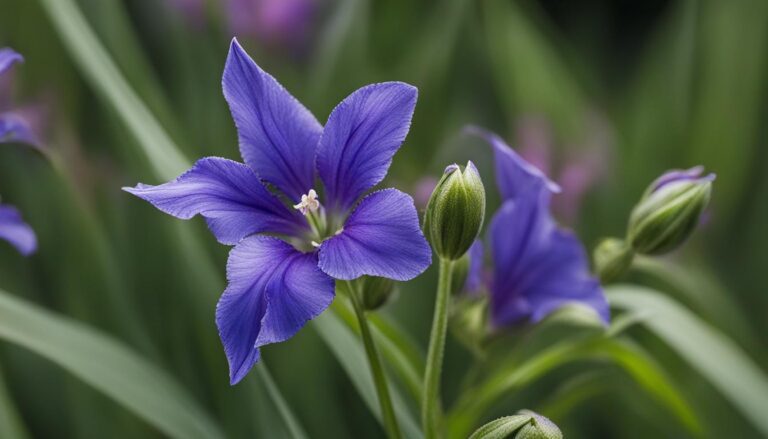
Welcome to my guide on mastering the growth of the Asparagus Fern (Asparagus setaceus) in your garden. Asparagus ferns are versatile indoor plants that can add beauty to any space, whether it’s inside your home or outside in your garden.
In this article, I will provide you with essential care tips to ensure your Asparagus Fern thrives and remains healthy.
When it comes to growing Asparagus Fern, the right location is crucial. These houseplants thrive in bright, indirect sunlight, so choose a spot that provides partial shade or filtered sunlight. Additionally, good air circulation is essential, so selecting a location that allows for adequate air movement is ideal.
Asparagus ferns prefer well-draining soil that is rich in organic matter. A mixture of peat moss, perlite, and potting soil works well to provide the proper conditions for their growth. Remember to water your Asparagus Fern when the top inch of soil feels dry, and avoid overwatering to prevent root rot.
Regular pruning is necessary to maintain the shape and health of your Asparagus Fern. Remove any yellow or brown fronds and keep an eye out for dead or damaged foliage. For propagation, you can divide the plant or plant the collected seeds in well-draining potting mix.
Lastly, be aware of common pests such as spider mites, mealybugs, and scale insects. Treat any infestations with appropriate insecticidal soap or oil to keep your Asparagus Fern healthy.
By following these care tips and providing the proper conditions, your Asparagus Fern will thrive and add beauty to your indoor or outdoor spaces for years to come.
Asparagus Fern Varieties and Benefits
Asparagus Fern Varieties
Asparagus ferns come in a variety of types, each with its own unique appearance and growth habit. Some popular varieties include:
- Asparagus densiflorus: This variety features dense, bushy foliage and delicate, feathery fronds.
- Asparagus plumosus: Known as the lace fern, this variety has finely-textured foliage that resembles delicate lacework.
- Asparagus sprengeri: With long, cascading branches filled with needle-like leaves, this variety is often used in hanging baskets and floral arrangements.
These different varieties allow you to choose the asparagus fern that best complements your personal style and garden aesthetic.
Benefits of Asparagus Ferns
Asparagus ferns offer more than just their attractive appearance. Here are some key benefits of having asparagus ferns in your garden:
- Texture and Visual Interest: The delicate, lush foliage of asparagus ferns adds texture and visual interest to both indoor and outdoor spaces, making them a popular choice among gardeners and landscapers.
- Air-Purifying Properties: Asparagus ferns are known for their ability to purify the air, helping to improve the overall air quality in your home or garden.
- Non-Toxic: Asparagus ferns are non-toxic to humans and pets, making them a safe choice for households with animals or small children.
With their variety and numerous benefits, asparagus ferns are a versatile and rewarding addition to any garden or indoor space.
Comparison of Asparagus Fern Varieties
| Variety | Appearance | Growth Habit |
|---|---|---|
| Asparagus densiflorus | Dense, bushy foliage; delicate, feathery fronds | Upright and spreading |
| Asparagus plumosus | Finely-textured foliage resembling delicate lacework | Trailing, cascading |
| Asparagus sprengeri | Long, cascading branches with needle-like leaves | Trailing, hanging |
Asparagus Fern Care During Drought and Dry Spells
When it comes to caring for your Asparagus Fern (Asparagus setaceus) during periods of drought and dry spells, there are a few key considerations to keep in mind. Despite their reputation for drought tolerance, these plants still require some level of moisture to thrive.
Watering Requirements: Asparagus ferns have low to moderate watering needs. During dry spells, it is important to monitor the moisture level of the soil. Water the plant when the top layer of soil feels dry, ensuring that the soil is moist but not waterlogged to prevent root rot.
Soil Requirements: Asparagus ferns do well in well-draining soil that allows for easy water movement. This type of soil helps prevent excessive water retention, which can lead to root rot. Ensure the soil is kept moist throughout drought periods.
Light, Temperature, and Humidity: Asparagus ferns thrive in bright, indirect light or morning sun. They prefer a temperature range of 60-70°F (15-21°C) and moderate to high humidity levels. During hot and dry periods, providing shade and mulching around the plant can help retain moisture and protect the fern from wilting.
By following these care tips, you can ensure that your Asparagus Fern remains healthy and resilient even during drought and dry spells.
FAQ
What is the best location for growing asparagus ferns?
Asparagus ferns thrive in bright, indirect sunlight. Choose a location that provides partial shade or filtered sunlight.
How important is air circulation for asparagus ferns?
Good air circulation is important for asparagus ferns. Select a location that allows for adequate air movement.
What type of soil do asparagus ferns prefer?
Asparagus ferns prefer well-draining soil that is rich in organic matter. A mixture of peat moss, perlite, and potting soil works well.
How often should I water my asparagus fern?
Water the plant when the top inch of soil feels dry. Avoid overwatering to prevent root rot.
How should I fertilize my asparagus fern?
Fertilize your asparagus fern every four to six weeks during the growing season with a balanced, water-soluble fertilizer.
Is pruning necessary for asparagus ferns?
Yes, regular pruning is essential to maintain the shape and health of your asparagus fern. Remove any yellow or brown fronds and watch out for dead or damaged foliage.
How can I propagate asparagus ferns?
Asparagus ferns can be propagated through division or by collecting and planting seeds. Divide the plant carefully by separating congested roots and replanting them in separate containers. For seed propagation, collect seeds from mature berries and sow them in well-draining potting mix.
What are common pests for asparagus ferns?
Common pests for asparagus ferns include spider mites, mealybugs, and scale insects. Treat infestations with appropriate insecticidal soap or oil.
Are asparagus ferns safe for pets and children?
Yes, asparagus ferns are non-toxic to humans and pets, making them a safe choice for households with animals or small children.
How do asparagus ferns benefit indoor and outdoor spaces?
Asparagus ferns add texture and visual interest to both indoor and outdoor spaces. They also have air-purifying properties and are known to improve air quality. Additionally, they are non-toxic, making them a safe choice for homes with pets or children.
How do I care for asparagus ferns during drought or dry spells?
During dry spells, monitor the soil moisture level and water the plant when the top layer of soil feels dry. Providing shade and mulching can also help retain moisture and protect against extreme temperatures.






